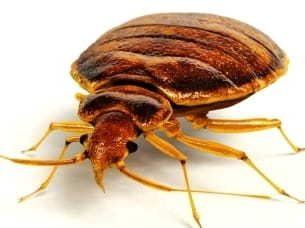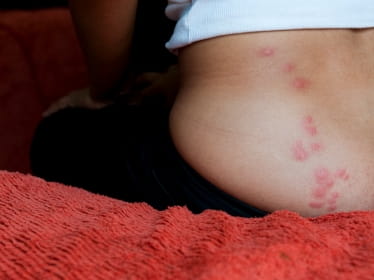Bedbugs: Sleep Tight

The Bottom Line
Bedbugs are becoming more common. They are alarming and can cause uncomfortable bites. They do not cause human illness. Eliminating an infestation may require the assistance of a professional pest control operator.

The Full Story
The bed bug (Cimex lectularius) nearly disappeared in the United States after World War II. Lately, bed bugs have been found again in homes and workplaces across the country. Why? No one knows for sure. Possible reasons are foreign travel, pesticide resistance, and changes in pesticide use.
Bed bugs usually can be seen by the human eye. They may resemble an apple seed: reddish-brown in color, oval, flat, and about a quarter of an inch long. Younger bed bugs may be lighter in color and smaller in size.
Bed bugs lurk in their namesake…beds. This can include the cracks and crevices of the mattress, headboard, bed frame, and box spring. They also may hide in other upholstered items like furniture, curtains, and rugs. Bedbugs hide so well that they can even be found behind peeling wallpaper, light plates and outlets. You may have bed bugs if you notice spots or smears on fabric. Or, you may see actual eggs or egg shells. Some people describe a sweet, musty odor.
The good news is that bed bugs are not known to transmit diseases to humans. Bites may appear like other insect bites causing red spots and itchiness. Such bites may lead to skin infections. Some people have an allergic-like response. Generally bites can be managed at home. Keep the area clean and dry. Use hydrocortisone or diphenhydramine to treat itching.
The bad news is that bed bugs are a nuisance. They can be difficult to remove once an infestation occurs. To prevent an infestation:
- Carefully inspect any second-hand items you bring into your home.
- If you travel, inspect the bed and frame before sleeping in it.
- When you get home, immediately remove your clothes from your suitcase. Wash and dry them right away.
- Decrease any clutter in the home that may be a hiding place for bedbugs.
- Reduce areas in and around the home that shelter or attract birds and bats, as they may also harbor bedbugs.
- Plastic casings on pillow and mattresses may help keep bed bugs out.
If you know or suspect that you have bed bugs, take these steps:
- Vacuum the areas well.
- Wash bedding and fabrics in hot water (at least 120°F); dry them for at least 20 minutes.
- Or, use cold treatments (below 0°F for four days) or heat treatments (over 113°F).
You can buy pesticides to treat bed bugs yourself. Or, you can contract with a pest control service to treat your home. If you decide to apply a pesticide, use care:
- Always read the label first.
- Do not use a product intended to kill another type of pest.
- If you have children or pets, make sure the product you are using is safe for them.
- Look on the label for the EPA registration number. This means that the Environmental Protection Agency has approved the product for sale.
- Follow directions exactly.
- Wait for the recommended time before going back into the area.
- Never use a product intended for outside use inside.
Amanda McDaniel-Price, RN, BA, BSN
Certified Specialist in Poison Information
Poisoned?
Call 1-800-222-1222 or
Prevention Tips
Bedbugs can be difficult to remove once an infestation occurs. To prevent an infestation:
- Carefully inspect any second-hand items you bring into your home.
- If you travel, inspect the bed and frame before sleeping in it.
- When you get home, immediately remove your clothes from your suitcase. Wash and dry them right away.
- Decrease any clutter in the home that may be a hiding place for bedbugs.
- Reduce areas in and around the home that shelter or attract birds and bats, as they may also harbor bedbugs.
- Plastic casings on pillow and mattresses may help keep bed bugs out.
This Really Happened
A 50-year-old woman called Poison Control about a bed bug infestation at her home. She had already set off multiple insecticide bombs, cleaned her bed linens and even bought a new bed but the problem persisted. She had multiple bites and generalized itching. She was applying a topical hydrocortisone cream to her skin. Poison Control recommended that she might try taking oral diphenhydramine (Benadryl®) and that she contact an exterminator, which she did. She was seen by her primary care physician for further bite treatment after calling Poison Control.
For More Information
Two EPA guides may help you treat these annoying pests:
References
Studdiford JS, Connitt KM, Trayes KP, Tully AS. Bedbug infestation. Am Fam Physician. 2012;86(7):653-658.Poisoned?
Call 1-800-222-1222 or
Prevention Tips
Bedbugs can be difficult to remove once an infestation occurs. To prevent an infestation:
- Carefully inspect any second-hand items you bring into your home.
- If you travel, inspect the bed and frame before sleeping in it.
- When you get home, immediately remove your clothes from your suitcase. Wash and dry them right away.
- Decrease any clutter in the home that may be a hiding place for bedbugs.
- Reduce areas in and around the home that shelter or attract birds and bats, as they may also harbor bedbugs.
- Plastic casings on pillow and mattresses may help keep bed bugs out.
This Really Happened
A 50-year-old woman called Poison Control about a bed bug infestation at her home. She had already set off multiple insecticide bombs, cleaned her bed linens and even bought a new bed but the problem persisted. She had multiple bites and generalized itching. She was applying a topical hydrocortisone cream to her skin. Poison Control recommended that she might try taking oral diphenhydramine (Benadryl®) and that she contact an exterminator, which she did. She was seen by her primary care physician for further bite treatment after calling Poison Control.
